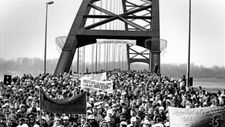
Change Overtakes Standstill
Empty factories, crumbling pithead winding towers, demonstrating workers: the structural change in North Rhine-Westphalia brought massive upheavals along with it.
You can retrace this change in the exhibition room in three areas: the coal and steel industries, agriculture, and the textile industry. Each section is symbolically represented by a conveyor belt.
The first and third belts show the rise and fall of the coal, steel and textile industries. After the war, the economy flourished, but with the end of the “economic miracle” these sectors experienced several crises: coal, steel and clothing from Germany had to compete with cheap imports while demand declined. The Ruhr in particular became emblematic of a region suffering setbacks and disadvantages.
The centre belt exhibits the particular developments that the farming sector experienced: New found prosperity and the high demand for inexpensive foodstuffs promoted agriculture geared towards quantity and growth. Farmers thus became dependant on trade and industry. Meanwhile, many came to change their thinking; quantity does not mean quality.